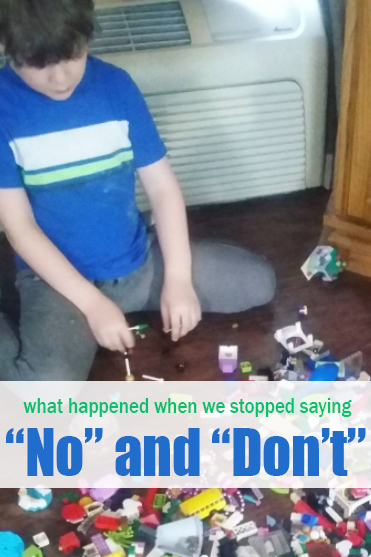
“No! Don’t touch those!” I heard myself scolding my son at the store, encouraging him to leave the tags on the shelves alone. Unfortunately, all my son heard was “touch those!” which just led to me scolding him again. I didn’t realize that the way I said things, and the way I told him not to do something and scolded him when he didn’t do as I asked were creating a cycle of him disobeying.
It turns out that how we talk to kids, both before and after they do something they shouldn’t, sincerely shapes the amount of response we’ll get from them. It also shapes their self-esteem and their self-talk later in life.
When you walk into Target, I can guarantee you’ll hear a chorus of parents. “No!” “Don’t!” “Stop!” It’s common nature for most parents. We forget how kids learn by the time we are adults, making it harder for us to speak in relatable ways.
Consider the following statements:
“Don’t touch that tag.”
“Don’t stand on the cart!”
“Don’t push that button.”
You think you’re making things very clear. In your mind, you have told your child exactly what not to do. So why aren’t they hearing you? Because they’re only hearing the end of your statements. In their mind, they focus on “touch that tag,” “stand on the cart,” and “push that button,” with their mind blocking out the “don’t” to some degree or another. They may recognize that you don’t want them to do it, but in the process, their mind affirms that yes, they should.
Using Positive Opposites to Support Good Listening
One of my son’s therapists made this distinction clear in a session. When we preface phrases with “no,” or “don’t,” we aren’t making it easy for kids to listen or respond in the way we expect them to. We’re adding an extra layer they have to think about– to listen to what we’re referring to, like touching the button or standing on the cart — and then forcing them to modify it with the word at the beginning (no or don’t) that tells them to NOT do that. Sometimes, by the time they process, they’ve done the opposite thing from what you want them to.
Clearly State What You Want Instead of Saying What You Don’t
Consider the following alternatives to the phrases I shared above.
“Please keep your hands to yourself.”
“Let’s walk next to the cart and hold onto it for safety.”
“Can you hold my grocery list for me?”
You’re not saying no or don’t– you’re telling them clearly what you want them to do instead of the undesirable behavior they’re trying to do. It makes the statement easier to understand (so they aren’t trying to reverse it in their mind) and gives them a clear instruction.
Compliment Good Behavior to Encourage More Good Behavior
Rather than scolding your child for not doing what you asked, praise them when they do hit the mark and do what they’re supposed to. Praise them even more when they do it without you having to tell them.
Are you wanting your child to stop jumping on the furniture? Every time — and I do mean every time — you see them sit down on it nicely, you need to say “Great job sitting nicely!” or “Thank you so much for sitting down nicely!”
Kids love praise. They love knowing they’ve done well. So be pro-active– don’t wait until they’re doing what you’ve asked. Praise them when they do it naturally. Of course, praise them when you’ve asked them to do something and they do it, as well.
What Happened When We Tried It
I had some serious doubts about implementing this. I mean, in theory, it sounded like it made sense. I get encouraging kids to be good by giving them praise, and I get the idea of telling them the behavior you want instead of telling them what you don’t want.
I did not believe it would make a massive difference in our lives. I expected that it might help, but I didn’t expect for it to take our meltdowns from several a day to a few a week. It was a night-and-day difference in his behavior. Things started clicking.
So what didn’t work? Getting everyone on board. This is a method that works best when applied consistently. It can be hard to remember, but with practice, you can definitely make it happen consistently. The challenge is making sure to get the whole family on board with the change. You as parents may remember, but if grandparents forget, that can cause some stress and strain. Or, vice versa… if the grandparents are working hard to make it happen, but you aren’t holding up your end of the deal at home, then it’s never going to work out.
Keys to Success
In short, there are three keys to remember:
- Tell your kids what you want them to do, instead of telling them what not to do. Instead of “Don’t slam the door!” say “Please shut the door nicely. Thank you!”
- Praise your kids when they do the correct thing. “Great job closing the door nicely!”
- Praise them when they do the correct thing without being instructed to.
- Get everyone on board and stay consistent– this only works well when everyone is involved.
What is your secret to helping your kids learn great listening skills?
Let me know in the comments below!
More Resources on Positive Opposites
Ronald Crouch, Ph.D.’s Resources on Using Positive Opposites with Children
Increasing Obedience with Positive Opposites from Cornerstones for Parents
Positive Opposites from SmarterParenting
More Parenting Resources
Effective Parenting Through Your Child’s Meltdowns
No, I Won’t Make My Son Wear Pants
It Takes a Village (Without Judgment)
Why I Still Hold My Son
Disclaimer: I’m not a psychologist or psychiatrist. These are just tips from my son’s psychologist and plenty of others who have done research on this subject.




